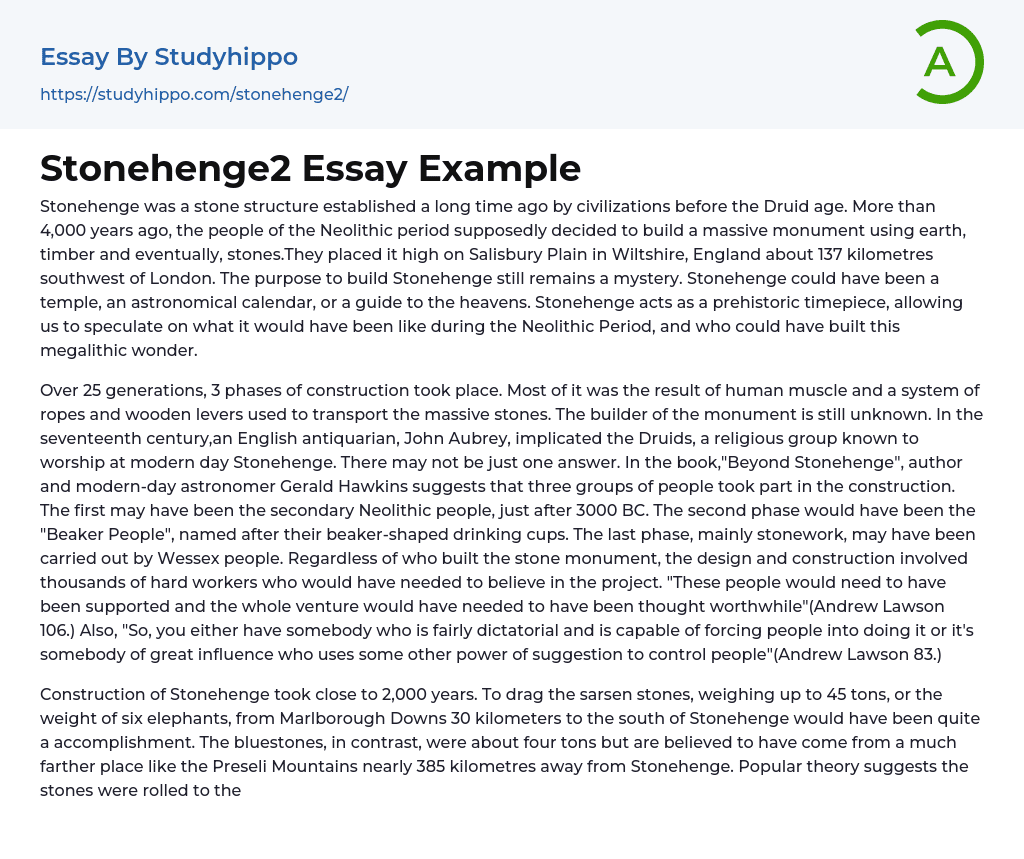Stonehenge, a pre-Druid era stone structure, was created by ancient civilizations. Over 4,000 years ago, the Neolithic people constructed a monumental site using earth, timber, and eventually stones. Situated on Salisbury Plain in Wiltshire, England, Stonehenge is approximately 137 kilometers southwest of London. The purpose of this enigmatic structure remains unknown and continues to captivate our curiosity. Various theories propose it may have served as a temple, an astronomical calendar or a celestial guide. As an artifact from the past, Stonehenge allows us to speculate about life during the Neolithic period and the architects responsible for this remarkable megalithic marvel.
The text discusses the construction of Stonehenge, which occurred in three phases over 25 generations. Human muscle, ropes, and wooden levers were used to transport the massive stones. The builder remains unknown, but theories suggest involvement from
...the Druids, a religious group who worshipped at the site. Gerald Hawkins proposed in his book "Beyond Stonehenge" that three different groups participated in construction: secondary Neolithic people, "Beaker People," and Wessex people. Thousands of workers believed in its worthiness and contributed to the project which lasted for almost 2,000 years.
Transportation of sarsen stones weighing up to 45 tons (equivalent to six elephants) from Marlborough Downs (30 kilometers south of Stonehenge) would have been an impressive achievement. In contrast, bluestones around four tons are believed to have come from a much farther place like Preseli Mountains (approximately 385 kilometers away). One popular theory suggests rolling them to the Welsh shore and using rafts along the coast into River Avon at Bristol for transportation. However, some prehistorians dispute this idea and reject such distant stone transportation beliefs.The bluestones used in
Stonehenge were sourced from the Preseli Mountains and brought to the area during the Plyoscene period, approximately 650,000 years ago. Most stone circles in Britain, Ireland, and Brittany are made using local stones from distances no greater than seven or eight kilometers. However, at Stonehenge, a mix of good, bad, and medium quality bluestones were found. Evidence suggests that good bluestones were already present in the vicinity of Stonehenge prior to its construction. This indicates that a glacier may have transported them there instead of humans deliberately selecting only the best stones (Audbrey Baul 78). Stonehenge has an intricate arrangement of stones thought to be influenced by celestial movements such as the moon and sun. It potentially served as a temple or an astronomer's tool for observing these celestial movements (Witcombe 34). Despite its long construction period, there are various theories about its purpose.In the 18th century, William Stukeley, an antiquarian, observed the sunrise in June and concluded that Stonehenge could be a temple for the Druids. Despite its waning popularity, this theory still influences the interpretation of Stonehenge as having religious significance. Another viewpoint, presented by Sir Norman Lockyer, a British astronomer in the 20th century, suggests that Stonehenge was a sun temple used for Celtic festivities. However, Witcombe asserts that it may be presumptuous to view Stonehenge solely as a temple or with religious qualities. Its unique structure sets it apart from houses or halls and implies its sacred nature. Additionally, some believe that people desired to be buried near Stonehenge, further highlighting its spiritual importance and concerns about the afterlife (Hawkins 68). Another mid-20th-century theory proposes that Stonehenge functioned as an astronomical
calendar marking lunar and solar alignments. The main monument contains four stones known as "Station Stones" thought to have played a role in astronomical observations. These stones form a rectangle within the surrounding ditch and bank and are believed to indicate moonrise, moonset, sunrise, and sunset (Aubrey; Baul; Hawkins; Lawson; Witcombe).
- Agriculture essays
- Albert einstein essays
- Animals essays
- Archaeology essays
- Bear essays
- Biology essays
- Birds essays
- Butterfly essays
- Cat essays
- Charles Darwin essays
- Chemistry essays
- Dinosaur essays
- Discovery essays
- Dolphin essays
- Elephant essays
- Eli Whitney essays
- Environmental Science essays
- Evolution essays
- Fish essays
- Genetics essays
- Horse essays
- Human Evolution essays
- Isaac Newton essays
- Journal essays
- Linguistics essays
- Lion essays
- Logic essays
- Mars essays
- Methodology essays
- Mineralogy essays
- Monkey essays
- Moon essays
- Mythology essays
- Noam Chomsky essays
- Physics essays
- Plate Tectonics essays
- Progress essays
- Reaction Rate essays
- Roman Numerals essays
- Scientific essays
- Scientific Method essays
- Scientist essays
- Seismology essays
- Space Exploration essays
- Stars essays
- Sun essays
- Thomas Edison essays
- Tiger essays
- Time Travel essays
- Universe essays




